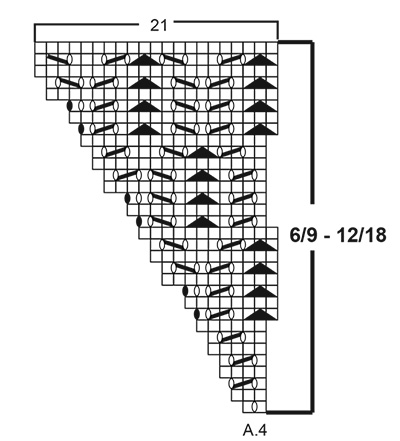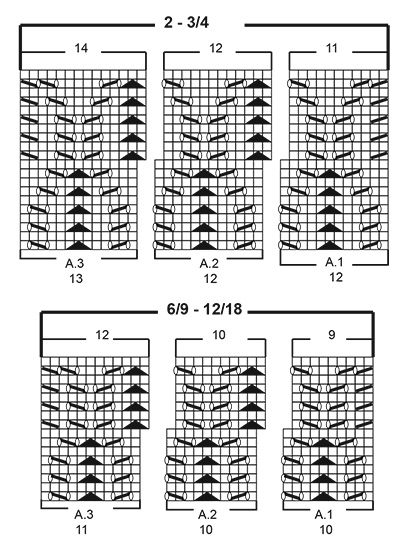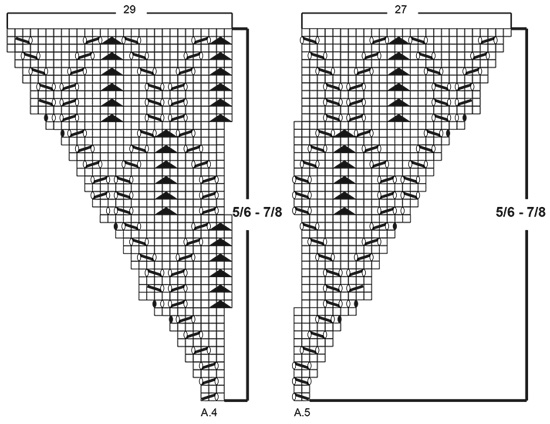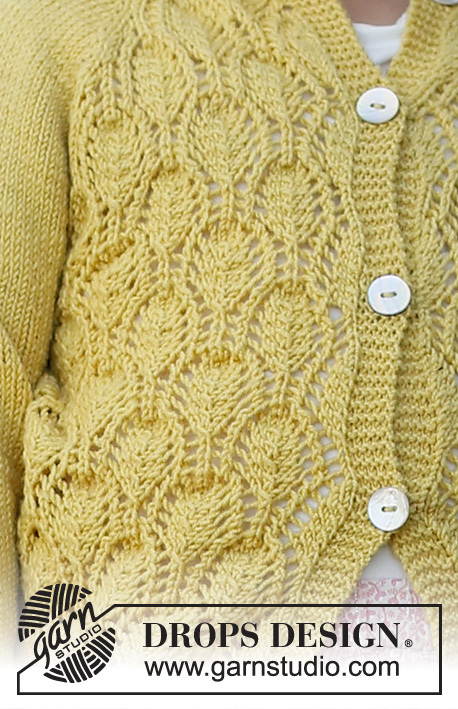Sweet Marigold |
|||||||||||||||||||
 |
 |
||||||||||||||||||
Knitted jacket for baby and kids in DROPS BabyMerino. Piece is knitted top down with raglan pattern and lace pattern. Size 6 month - 8 years
DROPS Baby & Children 38-11 |
|||||||||||||||||||
|
------------------------------------------------------- EXPLANATION FOR THE PATTERN: ------------------------------------------------------- GARTER STITCH (back and forth): 1 ridge = knit 2 rows. GARTER STITCH (in the round - applies to sleeves): 1 ridge = 2 rounds. Knit 1 round and purl 1 round. PATTERN: See diagrams A.1 to A.5. Choose diagram for your size. INCREASE TIP (evenly): To calculate how to increase evenly, use the total number of stitches on row (e.g. 82 stitches), minus bands (e.g. 10 stitches) , and divide the stitches by number of increases to be done (e.g. 7) = 10.3. In this example increase by making 1 yarn over after approx. every 10th stitch. Do not increase over band stitches. On next row knit yarn over twisted to avoid holes. RAGLAN: All increases are done on a row from right side! On front and back piece raglan increase is shown in diagrams. Increase for raglan on each of the sleeves as follows: Increase 1 stitch after 1st and 3rd marker and before 2nd and 4th marker by making a yarn over. Purl yarn overs twisted on next row (= from wrong side). Then work the new stitches in stockinette stitch. DECREASE TIP (applies to sleeves): Decrease 1 stitch on each side of marker thread as follows: Work until 3 stitches remain before stitch with marker thread, knit 2 together, knit 3, slip 1 stitch knitwise, knit 1, pass slipped stitch over stitch worked. BUTTONHOLES: Decrease for buttonholes on right band (when garment is worn). Decrease from right side when 3 stitches remain on row as follows: Make 1 yarn over, knit the next 2 stitches together, knit last stitch. On next row knit yarn over to make hole. Decrease for first buttonhole when rib in neck measures approx. 1-1½ cm = ⅜"-½". Then decrease the next 4-4 (4-4-5-5) buttonholes, approx. 6- 6½ (7-7½-7-7½) cm = 2⅜"- 2½"(2¾"-2⅞"-2¾"-2⅞") between each. BIND-OFF TIP: To avoid a tight bind-off edge you may use a larger needle size. If this also is too tight, work a 1 yarn over after approx. every 4th stitch while binding off (bind off yarn overs as regular stitches). ------------------------------------------------------- START THE PIECE HERE: ------------------------------------------------------- JACKET - SHORT OVERVIEW OF THE GARMENT: Work back and forth on circular needle from mid front, work top down. Work sleeves in the round on double pointed needles, top down. NECK EDGE: Cast on 82-86 (92-95-100-104) stitches (including 5 band stitches in each side towards mid front) on circular needle size 2.5 MM = US 1.5 with Baby Merino. Work 4 ridges in GARTER STITCH - read explanation above. Decrease for BUTTONHOLES on right band - read explanation above. Knit 1 row from right side while increasing 7-3 (3-0-9-5) stitches evenly - read INCREASE TIP = 89-89 (95-95-109-109) stitches. Purl 1 row from wrong side inside with 5 band stitches in garter stitch towards mid front. Insert 1 marker thread inside 5 band stitches. NOW MEASURE PIECE FROM HERE! Switch to circular needle size 3 MM = US 2.5 and work yoke as explained below. REMEMBER THE KNITTING GAUGE! YOKE: Work next row as follows from right side: Left front piece: Work 5 band stiches in garter stitch, A.1 (= 10-10 (12-12-14-14) stitches), A.4 (= 2-2 (1-1-3-3) stitches). Left sleeve: Work 1 stitch in stockinette stitch, insert 1st marker, make 1 yarn over, work 14 stitches in stockinette stitch, make 1 yarn over, insert 2nd marker, 1 stitch in stockinette stitch. Back piece: Work A.5 (= 1-1 (1-1-2-2) stitches), A.2 over 20-20 (24-24-28-28) stitches, A.4 over 2-2 (1-1-3-3) stitches. Right sleeve: Work 1 stitch in stockinette stitch, insert 3rd marker, make 1 yarn over, work 14 stitches in stockinette stitch, make 1 yarn over, insert 4th marker, 1 stitch in stockinette stitch. Right front piece: Work A.5 over 1-1 (1-1-2-2) stitches, A.3 (= 11-11 (13-13-15-15) stitches) and finish with 5 band stitches in garter stitch = 97-97 (103-103-113-113) stitches (including all yarn overs). Continue pattern like this and increase for RAGLAN - read explanation above on every row from right side 14-16 (17-18-19-20) times in total (including increases on first row from right side after neck edge). When increase for sleeves are finished, continue in stockinette stitch and pattern as before. After last increase for raglan and A.4/A.5 have been worked 1 time vertically, there are 219-227 (255-259-287-291) stitches on needle. Piece measures approx. 10-10 (12-12-15-15) cm = 4"-4" (4¾"-4¾"-6"-6") from neck edge. Now work pattern as follows (from right side): Left front piece: Work 5 band stitches in garter stitch, A.1 over 10-10 (12-12-14-14) stitches, A.2 over 10-10 (12-12-14-14) stitches, A.3 over 11-11 (13-13-15-15) stitches. Left sleeve: Work 43-47 (49-51-53-55) stitches in stockinette stitch. Back piece: Work A.1 over 10-10 (12-12-14-14) stitches, A.2 over 40-40 (48-48-56-56) stitches (= 4 times in width), A.3 over 11-11 (13-13-15-15) stitches. Right sleeve: Work 43-47 (49-51-53-55) stitches in stockinette stitch. Right front piece: Work A.1 over 10-10 (12-12-14-14) stitches, A.2 over 10-10 (12-12-14-14) stitches, A.3 over 11-11 (13-13-15-15) stitches and finish with 5 band stitches in garter stitch. Continue pattern like this until piece measures 12-13 (14-15-16-17) cm = 4¾"-5⅛" (5½"-6"-6¼"-6¾") from marker thread after neck edge - adjust so that last row is from right side. Work next row as follows from wrong side: Continue with band and pattern as before over the first 36-36 (42-42-48-48) stitches (= front piece), slip the next 43-47 (49-51-53-55) stitches on 1 stitch holder for sleeve, cast on 9-9 (11-11-13-13) new stitches on needle (= in the side under sleeve), continue with pattern as before over the next 61-61 (73-73-85-85) stitches (= back piece), slip the next 43-47 (49-51-53-55) stitches on 1 stitch holder for sleeve, cast on 9-9 (11-11-13-13) new stitches on needle (= in the side under sleeve) and continue with pattern as before over the last 36-36 (42-42-48-48) stitches (= front piece). Finish body and sleeves separately. BODY: = 151-151 (179-179-207-207) stitches. On next row as follows from right side (continue on correct row in diagram): Work 5 band stiches in garter stitch, A.1 over 10-10 (12-12-14-14) stitches, A.2 over 120-120 (144-144-168-168) stitches (= 12 times in width), A.3 over 11-11 (13-13-15-15) stitches and 5 band stitches in garter stitch. Continue the pattern like this until piece measures 14-15 (17-19-22-25) cm = 5½"-6" (6¾"-7½"-8¾"-9¾") from division - adjust so that next row is worked from right side. Switch to circular needle size 2.5 MM = US 1.5. Work 3 ridges back and forth over all stitches. Bind off by knitting– read BIND-OFF TIP. SLEEVES: Slip the 43-47 (49-51-53-55) stitches from stitch holder in one side of piece on double pointed needles size 3 MM = US 2.5 and pick in addition up 1 stitch in each of the 9-9 (11-11-13-13) new stitches cast on under sleeve = 52-56 (60-62-66-68) stitches. Insert 1 marker thread in the middle stitch under sleeve and begin round here. Work in stockinette stitch in the round. When piece measures 2 cm = ¾" from division, decrease 2 stitches mid under sleeve - read DECREASE TIP. Decrease like this every 1½-1½ (2-3-3-3) cm = ½"-½" (3/4"-1⅛"-1⅛"-1⅛") 8-9 (9-8-9-9) times in total = 36-38 (42-46-48-50) stitches. Work until sleeve measures 16-19 (22-28-32-33) cm = 6¼"-7½" (8¾"-11"-12½"-13"). Switch to double pointed needles size 2.5 MM = US 1.5. Work 3 ridges in GARTER STITCH - read explanation above. Bind off by knitting. Sleeve measures approx. 17-20 (23-29-33-34) cm = 6¾"-8" (9"-11⅜"-13"-13⅜") from division. Work the other sleeve the same way. ASSEMBLY: Sew the buttons on to the left band. |
|||||||||||||||||||
Diagram explanations |
|||||||||||||||||||
|
|||||||||||||||||||

|
|||||||||||||||||||

|
|||||||||||||||||||

|
|||||||||||||||||||

|
|||||||||||||||||||

|
|||||||||||||||||||

|
|||||||||||||||||||
|
Have you made this or any other of our designs? Tag your pictures in social media with #dropsdesign so we can see them! Do you need help with this pattern?You'll find tutorial videos, a Comments/Questions area and more by visiting the pattern on garnstudio.com. © 1982-2024 DROPS Design A/S. We reserve all rights. This document, including all its sub-sections, has copyrights. Read more about what you can do with our patterns at the bottom of each pattern on our site. |
|||||||||||||||||||







































































Comments / Questions (33)
Jag stickar efter 6/9-12/18. Var ska jag ta den extra maskan som behövs till v 9 i A4.
08.09.2021 - 19:40DROPS Design answered:
Hei Helen. Bruk masken som er før du starter med A.4, altså i A.1 (siste maske "mangler" i A.1, rad 9). mvh DROPS design
15.09.2021 - 14:07Jeg laver en str. 98/104, og har lige strikket første retpind på bærestykket. Jeg får kun 101 masker i stedet for de 103, der står i opskriften. Jeg har talt efter, og synes at have lavet de omslag, der skal være, så hvad gør jeg forkert?
01.08.2021 - 13:36DROPS Design answered:
Hej Petronelle, hvis du sætter et mærke mellem hver rapport, så kan du let kontrollere at du har det rigtige antal masker i hver rapport og derved kan du let se i hvilken rapport du kan have glemt at tage ud. God fornøjelse!
04.08.2021 - 12:31Vilket A5 mönster skall användas till storlek 6/9-12/18. Det står på mönstret att man ska sticka 1 maska A5
17.07.2021 - 14:38DROPS Design answered:
Hej Mait, det stemmer, du finder diagram A.5 til 6/9-12/18 lige over A.1 A.2og A.3 som er nederst i opskriften. Du starter med 1 ret, 1 omslag osv :)
04.08.2021 - 11:09Hello, could you please advise how to adjust the pattern for XS women size? I would love to have the same sweater as my daughter (it would be great if more patterns were available in both children and adult sizes). Thank you in advance
12.07.2021 - 06:57DROPS Design answered:
Dear Marketa, we are unfortunately not able to adjust every pattern to every single request - you can take inspiration from our jacket for woman, some of them are starting with size XS. Your yarn store should be able to help you - even per mail or telephone. Thanks for your comprehension. Happy knitting!
12.07.2021 - 08:16Bonjour, je tricote la taille 12/ 18 mois, il est dit d'augmenter 9 mailles sous la manche , je voudrais savoir comment le dois les tricoter, c'est 9 mailles. Merci
18.05.2021 - 17:20DROPS Design answered:
Bonjour Mme Selem, ces 9 mailles sont relevées dans les 9 mailles montées lors de la division de l'empiècement, autrement dit, procédez comme dans la photo 18 B de cette leçon. Bon tricot!
19.05.2021 - 07:30Den er så fin.
13.05.2021 - 10:13I'm attempting to make this cardigan and am having trouble beginning the yoke. I have 5 band stitches on the left and on the right of the 95 stitches between. The beginning of the yoke has left front with 13st, left sleeve with 18st, back with 26st, right sleeve with 18st and finally right front with 14st, which equals 89 st, not 103st as stated in the pattern. Am I missing something? Shouldn't the right front be equal to the left front. Any help would be appreciated, Thank you
06.05.2021 - 22:15DROPS Design answered:
Dear Gabriele, You have not stated which size, so from the 95 stitch I will assume its for a 92 cm tall child. The 92 stitches cast on INCLUDE the band stitches, add 3 stitches after the garter stitch = 95 stitch. There are 8 yarnovers in the row (4 in the pattern for the front and back and 2X2 for the sleeves). If you add that to the 95 stitch you will get the stated 103 stitch. (the number of stitches are different in the two fronts because of the pattern). Happy Knitting!
06.05.2021 - 23:35Hvorfor skal der slås om i første omgang på ærmerne? Der er ingen videre forklaring, hvorfor der må formodes at de skal strikkes ret, men det giver jo huller i ærmerne?
01.05.2021 - 12:06DROPS Design answered:
Hei Mai. Det skal ikke legges opp nye masker når du strikker 1 omgang på ermene, men du skal strikke opp 1 maske i hver av de 9-9 (11-11-13-13) maskene som ble lagt opp under ermet. På den måten slipper du å sy igjen hullet under ermene. mvh DROPS design
03.05.2021 - 14:23Er der rettelser til mønstret? Når A1,2 og 3 er strikket fortsættes der så med A4/A5, og i hvilken rækkefølge?
27.03.2021 - 10:52DROPS Design answered:
Hei Anne-Grethe. Du strikker A.1, A.2, A.3, A.4 og A.5 samtidig og når A.1, A.2 og A.3 er strikket 1 gang i høyden gjentas disse i høyden i samme rekkefølge og når A.4 og A.5 er strikket 1 gang i høyden er det 219-227 (255-259-287-291) masker på pinnen og arbeidet måler ca 10-10 (12-12-15-15) cm fra halskanten. Les for videre strikk under: BÆRESTYKKET og "Nå strikkes det mønster videre slik (fra retten)". mvh DROPS design
07.04.2021 - 13:40Dobrý den, poradíte prosím, jak upravit vzor na dámskou velikost XS, ať můžeme mít s dcerkou stejný svetr? :) Předem děkuji.
21.03.2021 - 19:04